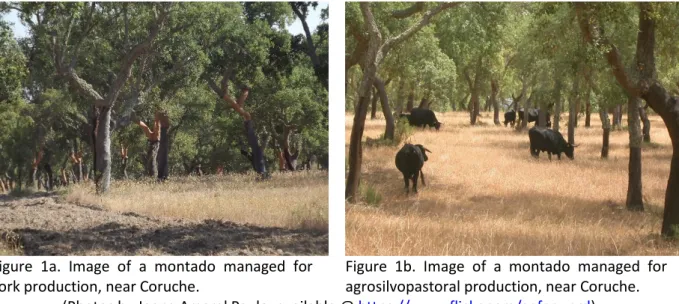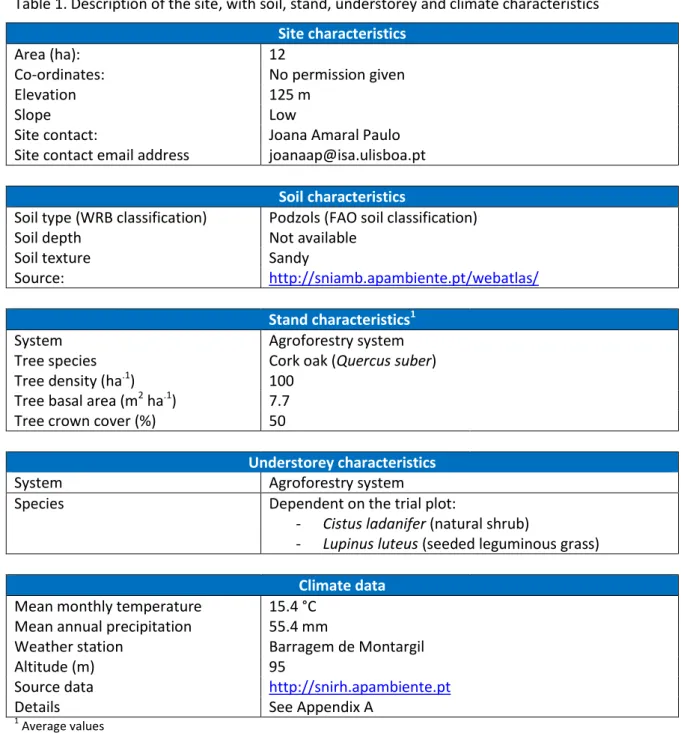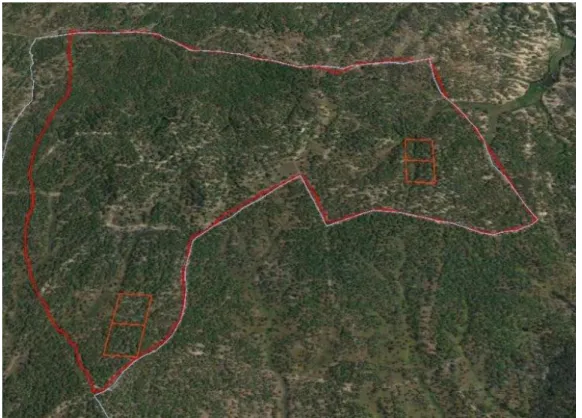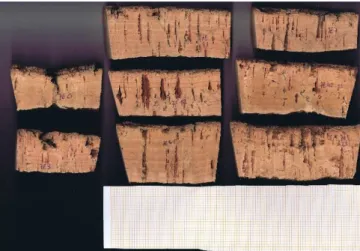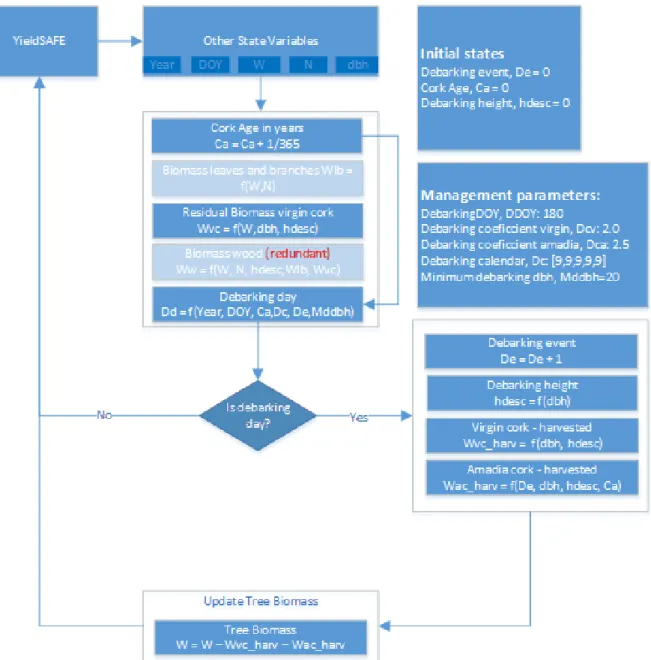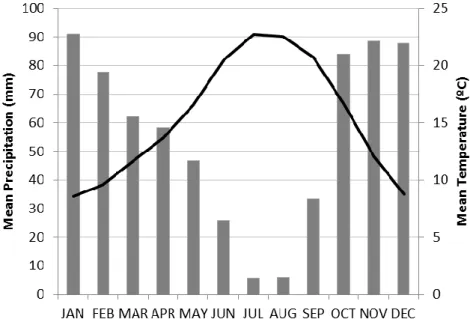AGFORWARD (Grant Agreement N° 613520) is co-funded by the European Commission, Directorate General for Research & Innovation, within the 7th Framework Programme of RTD. The views and opinions expressed in this report are purely those of the writers and may not in any circumstances be regarded as
Research and Development Protocol
for Cork Oak Woodland in Portugal
Project name AGFORWARD (613520)Work-package 2: High Nature and Cultural Value Agroforestry Specific group Montados in Portugal
Milestone Milestone 4 (2.3) Part of experimental protocol for WP2 Date of report 11 February 2015
Authors Joana Amaral Paulo, Sónia Pacheco Faias, Margarida Tomé, João H.N. Palma Contact joanaap@isa.ulisboa.pt
Approved Paul Burgess (9 May 2015)
Contents
1 Context ... 2
2 Background ... 2
3 System description ... 4
4 Trial design ... 5
5 Biophysical and economical modelling ... 7
6 Acknowledgements ... 8
7 References ... 9
1 Context
The AGFORWARD research project (January 2014-December 2017), funded by the European Commission, is promoting agroforestry practices in Europe that will advance sustainable rural development. The project has four objectives:
1. to understand the context and extent of agroforestry in Europe,
2. to identify, develop and field-test innovations (through participatory research) to improve the benefits and viability of agroforestry systems in Europe,
3. to evaluate innovative agroforestry designs and practices at a field-, farm- and landscape scale, and
4. to promote the wider adoption of appropriate agroforestry systems in Europe through policy development and dissemination.
This report contributes to the second objective. It contributes to the initial research and development protocol (Milestone 4 (2.3)) for the participative research and development network focused on agroforestry of high nature and cultural value.
2 Background
In Portugal, the main form of agroforestry is a traditional system called Montado. It is characterized by low density trees combined with arable or pastoral activities. The main tree species encountered in the Montado is cork oak (Quercus suber L), characterized by pure stands on average with 66 trees ha-1 (AFN 2010).
Agriculture, typically for cereal production, was a common practice since the thirteenth century even in areas recognized for their low productivity. The incentives given by kings and politicians for this activity were based on the necessity of dealing with the increased population of this region at that time (Fonseca 2008). During the 1980s, cereal production decreased and pastoral activities became dominant. Animal species include sheep, goats, pigs and cows, and the traditional breeds vary between regions and several are region specific.
Cork oak based Montado areas are included in the Portuguese National Forest Inventory (NFI) as part of the cork oak forest area, which occupies 736,775 ha (AFN 2010). The assessment of the evolution of the Montado areas in the last decade’s shows a stable value for the area of Montado were cork oak prevails, but a decrease in the number of trees per hectare with important consequences for the economic and ecological sustainability of the Montado areas, in particular in the ones were cork production is the main goal. This product is extracted at a minimum nine year interval defined by national legislation. Economic return is dependent on the price for cork and market fluctuations, reinforcing the importance of the multifunctional management of these areas, and of the impact of different management alternatives on the tree and cork growth.
The lack of information regarding the understory management of these areas in the NFI hampers the differentiation of both systems regardless of their differences: one managed for cork production (Figure 1a) and the other for agrosilvopastoral production (cork, sweet acorns, and animal and/or crop production – Figure 1b). The differences resulting from the diferent management systems are not only in the understory composition (species and abundance), but are also expected to affect tree regeneration, tree growth, cork growth and, to some extent, cork quality. This is the main goal of the
Figure 1a. Image of a montado managed for cork production, near Coruche.
Figure 1b. Image of a montado managed for agrosilvopastoral production, near Coruche. (Photos by Joana Amaral Paulo, available @ https://www.flickr.com/agforward)
This trial was originally started in 2003 in association with a private landowner, who demonstrated his interest in the issues of the impact of understory composition and management on cork growth and cork quality. This farmer contacted researchers from the Centro de Estudos Florestais from the Instituto Superior de Agronomia seeking help in trial design, analysis of the results and general technical support.
Meetings were held in 2002 and the trial was installed in 2003 (Campos 2003). The installation included the collection of the first set of cork samples, showing cork growth previous to the applications of the treatments. In 2012 measurements were made and new cork samples collected. These cork samples are now available for analysis and results assessment regarding the impact of the treatments along a complete nine year cork growth period, to carry out during the AGFORWARD project.
In 2012, after a field visit to the trial with the farmer, the design and the treatments to consider for the period 2012-2021 were redefined. As a result of the existing collaboration the farmer is one of the participants of the stakeholders group for the group Montado in Portugal, and was present at the initial meeting that took place on 24 July 2014 (Crous Douran et al. 2014). At this meeting, one of the topics identified as relevant for innovation testing was the impact of different management alternatives of the understory both for tree and cork growth. Taking advantage from the fact that the trees from the stand are characterized by two different cork extraction years (during a 9 years period two cork debarking operations are carried out in different tree of the stand: 2003 and 2006), the second occurring in 2015, cork samples will also be carried in May 2015, allowing to assess the impact of the treatments when applied in the first half of the cork growth cycle.
3 System description
The experimental trial took place in a cork oak woodland site located about 140 km East from Lisbon, near the village of Montargil. The stand presents an irregular structure, with the majority of the trees being more than 50 years old. The understorey is a natural pasture dominated by shrubs. Further details are given in Table 1.
Table 1. Description of the site, with soil, stand, understorey and climate characteristics Site characteristics
Area (ha): 12
Co-ordinates: No permission given
Elevation 125 m
Slope Low
Site contact: Joana Amaral Paulo
Site contact email address joanaap@isa.ulisboa.pt
Soil characteristics
Soil type (WRB classification) Podzols (FAO soil classification)
Soil depth Not available
Soil texture Sandy
Source: http://sniamb.apambiente.pt/webatlas/
Stand characteristics1
System Agroforestry system
Tree species Cork oak (Quercus suber)
Tree density (ha.1) 100
Tree basal area (m2 ha.1) 7.7
Tree crown cover (%) 50
Understorey characteristics
System Agroforestry system
Species Dependent on the trial plot:
- Cistus ladanifer (natural shrub)
- Lupinus luteus (seeded leguminous grass)
Climate data Mean monthly temperature 15.4 °C
Mean annual precipitation 55.4 mm
Weather station Barragem de Montargil
Altitude (m) 95
Source data http://snirh.apambiente.pt
Details See Appendix A
1
4 Trial design
4.1 Objective of the trial
The aim of the trial is to produce information about the effect of different understorey management practices on cork growth and resulting cork price. It is also expected to address the question of the effect of these management options on tree diameter growth.
4.2 Description of design
The trial is installed in two blocks, distanced about 2 km, each including 2 plots (Figure 2). Each plot is a quadrat with 2 ha. The total the trial performs 8 ha.
The design involves the comparison of two management alternatives:
no understorey removal along a complete cork debarking rotation period of 9 years,
periodic removal of the understory including organic matter incorporation and followed by installation of yellow lupin pasture (Lupinus luteus). The installation is repeated every 3 years.
Figure 2. Map of the experimental site in a pure cork oak stand. The management area, identified by the red line, is 308.8 ha.
4.3 Tree and cork measurements and sampling
On each debarking occasion the following measurements are carried out: a) Tree measurements in all trees:
Diameter at breast height (cm) Cork thickness (mm)
b) Tree measurements in the trees included in a 30 m radius circular plot located at the centre of each plot: Total height (m) Debarking height (m) Crown height (m) Crown diameter (m)
At each cork debarking and at each tree a cork sample measuring 20 cm x 20 cm is collected at breast height (Figure 3).
Figure 3. Cork sampling of a tree in the trial. Each cork sample is approximately 20 cm x 20 cm and is extracted at breast height.
Cork thickness is measured in the cork samples, at a mid-point in the two transverse sections using a digital gauge. The location of the measurement is marked. The cork samples are boiled for 1 h in
reaches equilibrium. The objective of this operation, which is the standard post-harvest operation for all raw corkboards, is to decrease internal tensions, caused by the cellular corrugation during cork growth, that are particularly important in the radial direction where cork thickness is measured (Pereira 2007). The cork thickness is again measured after boiling, in the same locations of the first measurement. Mean values for cork thickness before and after boiling are computed.
The samples are also used for cork quality classification. Cork quality is visually evaluated by an operator that, considering the cork porosity and the presence of cork defects, classifies the cork in 7 classes, from quality class 1 (best quality) to quality class 7 or “waste” (worst quality). Cork price is defined by the combination of cork thickness (caliper), measured after boiling and classified in classes, and cork quality. This combination is usually designated as a cork assortment.
The boiling operation and cork quality classification is made in the Associação e Produtores Florestais de Coruche (APFC) owners association. This association annually accomplishes several cork samplings in cork oak stands, and their operators are well trained for the task regarding the visual classification of cork quality, following the same standards used by the cork industry.
The cork samples are used for the measurement of annual cork growth rings using digital image analysis (Figure 4). This allows for the results to be analysed concerning the response variable ‘cork thickness’ that is related to cork price, but also to analyse the response variable of ‘annual cork growth’. The importance of this approach, including two different response variables, is related with the fact that it allows to research the existence of differences in the tree and cork growth, but also to assess if these differences, if any, are traduced in an increase of cork price.
Figure 4. Cork sample showing annual cork growth rings.
5 Biophysical and economical modelling
The second part of this protocol describes attempts to model the system using the YieldSAFE biophysical model. The YieldSAFE model has been parameterised for cork oak (Palma et al 2014). Whilst Palma et al. (2014) was successful in modelling cork oak biomass, no attempt was made to estimate cork allocation in the tree and/or the biomass of the extracted cork when debarking operations take place. The data from this experiment will complement other data being collected to hybridize YieldSAFE biomass estimation, because the cork is extracted periodically and needs to be
reflected in the process of biomass daily estimates. A preliminary schema of this implementation is provided:
Figure 5. Preliminary flowchart of the implementation of cork allocation and extraction into YieldSAFE
Farmer records on operational expenses of the experimental plots will be compared. The evaluation will assess if the cork grown with the lupins and grass is good enough to justify the decision to invest in the operations involved.
6 Acknowledgements
The AGFORWARD project (Grant Agreement N° 613520) is co-funded by the European Commission, Directorate General for Research & Innovation, within the 7th Framework Programme of RTD, Theme 2 - Biotechnologies, Agriculture & Food. The views and opinions expressed in this report are purely those of the writers and may not in any circumstances be regarded as stating an official position of the European Commission.
7 References
AFN (2010). Inventário Florestal Nacional Portugal Continental IFN5, 2005 - 2006. Autoridade Florestal Nacional, Lisboa, 209 pp. (http://www.icnf.pt/portal/florestas/ifn).
Campos, M. M. (2003). Installation of an experimental trial for the study of the effect of understory management on cork calibre and quality. Relatório de trabalho de fim de curso. Instituto Superior de Agronomia. Lisboa.
Crous-Duran, J., Amaral Paulo, J., Palma, J. (2014). Initial Stakeholder Meeting Report: Montado in Portugal. 4 September 2014. 12 pp. Available online:
http://www.agforward.eu/index.php/en/montado-in-portugal.html Fonseca, A. (2008). O Montado no Alentejo. Edições Colibri. Lisboa. 158 pp.
ICNF (2013). IFN6 – Áreas dos usos do solo e das espécies florestais de Portugal continental. Resultados preliminares. Instituto da Conservação da Natureza e das Florestas. 34 pp. Lisboa. http://www.icnf.pt/portal/florestas/ifn/resource/ficheiros/ifn/ifn6-res-prelimv1-1 Palma J.H.N., Paulo J.A., Tomé M. (2014) Carbon sequestration of modern Quercus suber L.
silvoarable agroforestry systems in Portugal: a YieldSAFE-based estimation, Agroforestry Systems, 88 (5) 791-808.
Appendix A. Climatic data
Local climatic data are presented in Figure A1 and A2.
Figure A1. Monthly average precipitation and temperature
Figure A2. Annual average precipitation and temperature recorded in the Barragem de Montargil station for the period 1958-2008. Missing values for temperature occur for the period 1991 to 2000
